I have extensive experience in the non-operative and surgical treatment of all types of shoulder problems, including shoulder trauma, sports medicine injuries and conditions requiring shoulder replacement .
Some of the shoulder surgeries I perform are:
- Arthroscopic Subacromial Decompression for Persistent Rotator Cuff Tendinitis
- Arthroscopic Labral Repairs for Recurrent Instability and SLAP repairs
- Arthroscopic Capsulorraphy for symptomatic Shoulder Ligamentous Laxaty
- Arthroscopic Single and Double Row repairs of full- thickness Cuff Tears
- Tenodesis for Tears of the Long Head of Biceps Tendon
- Repair of Pectralis Major Tendon Tears
- Mini open repair, with allograft tissue augmentation, for recurrent rotator cuff tears
- Repair and Reconstruction of Acromio-Clavicular Joint (AC Joint) dislocations
- Open Coracoid Bone Transfer (Latarget procedure) for Recurrent Shoulder Dislocations
- Total Shoulder Joint Replacement for Shoulder Arthritis and Osteonecrosis
- Reverse Total Shoulder Replacement for Cuff Tear Arthropathy and Severe Chronic Rotator Cuff Tears
I perform a limited range of elbow, wrist and hand surgeries including:
- Tennis Elbow Release
- Ulna Nerve Transposition for Nerve Compression
- Radial Head Replacement for Severe Radial Head Fractures
- Internal Fixation of Olecranon Fractures of the Elbow
- Internal Fixation of some Wrist Fractures
- Trigger Finger Release
- Carpal Tunnel Decompression
- De Quervain’s Tenosinovitis ( wrist tendinitis) Decompression
The following X-ray images show the before and after appearances of SHOULDER surgeries I have personally performed. In order to protect patients’ identities, their names have not been used and all identifying features have been removed from these images.
1. Patient “L” : Total Shoulder Replacement for Advanced Shoulder Osteoarthritis.
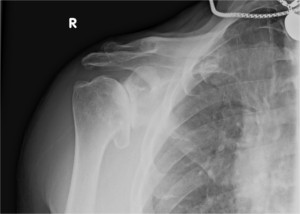
Before surgery for advanced shoulder arthritis.
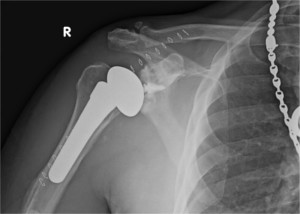
After surgery for advanced shoulder arthritis.
Total shoulder replacement is an operation that works as well as hips or knee replacements when done for advanced shoulder arthritis. The X-ray image on the left shows the loss of joint space and bone spur formation in the shoulder of patient “L”, a 56 year old man, who was severely disabled by pain and shoulder stiffness. The image on the right shows the replacement of the shoulder’s ball and socket which completely relieved his pain and restored excellent shoulder function.
2. Patient “M”: Reverse Total Shoulder Replacement For Cuff Tear Arthropathy.
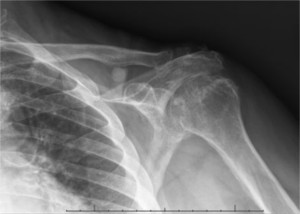
Before reverse shoulder surgery.
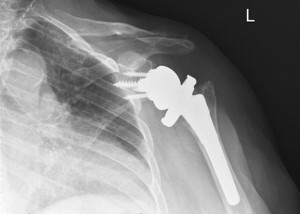
After Reverse Shoulder Surgery.
“M” was a 73 year old female patient with severe left shoulder pain and marked restriction of movement. She had advanced shoulder arthritis with a collapsed head of humerus and associated rotator cuff tear and atrophy. Her pain was relieved and good shoulder function restored by a reverse total shoulder replacement.
3. Patient “N”: Reverse Total Shoulder Surgery for Shoulder Fracture Dislocation, after previous failed Rotator Cuff Repair.
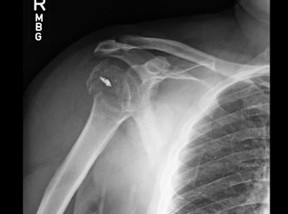
Before Reverse Total Shoulder Replacement.
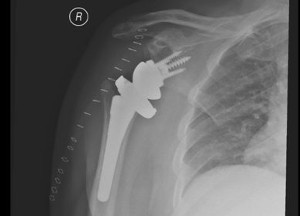
After Reverse Total Shoulder Replacement.
This 60 year old man came to me 2 weeks after suffering a severe shoulder injury from a fall. His X-rays showed a fracture with dislocation of the head of humerus. He had a rotator cuff repair several years earlier by another surgeon, which had failed, and the tear was not repairable. The head of humerus was pressing on the main blood vessels and nerves to his arm. A reverse total shoulder replacement combined with removal of the dislocated head of humerus completely relieved his pain and restored excellent shoulder function.
Note: A reverse total shoulder replacement is necessary whenever a shoulder replacement is performed in the presence of an irrepairable rotator cuff tear. A standard shoulder replacement will not work in this situation.
4. Patient “O”: Open Reduction and Internal Fixation of Severe Displaced Fracture – Dislocation of the Proximal Humerus.
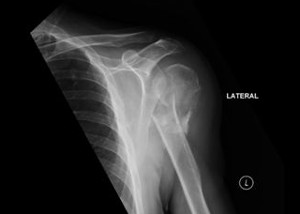
Before open reduction surgery.
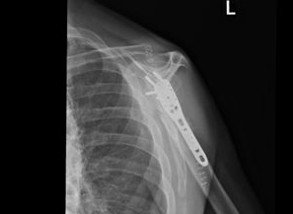
After open reduction surgery with bone allograft.
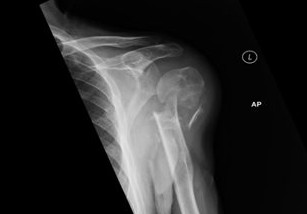
Before internal fixation surgery.
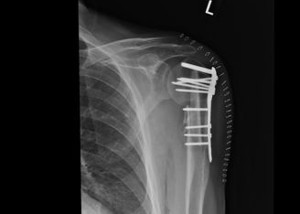
After internal fixation surgery with metal plate and screws.
Patient “O” ’s X-rays depict the fracture of a displaced and comminuted (many bone fragments) fracture – dislocation of the shoulder and proximal ( upper) humerus. In order to relieve his pain and restore good shoulder function, I performed open reduction and internal fixation (ORIF) of
the fracture using metal plate and screws, and a fresh frozen bone allograft from a cadaver
donor for additional stability of the fixation.

